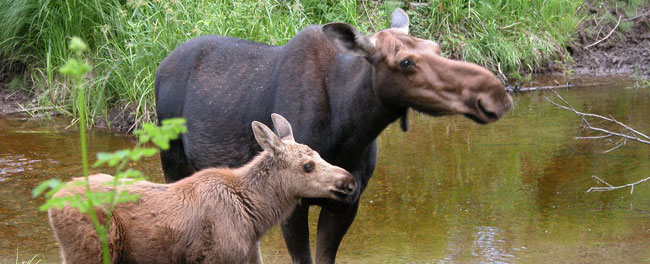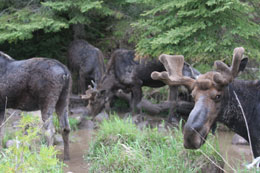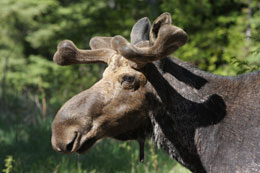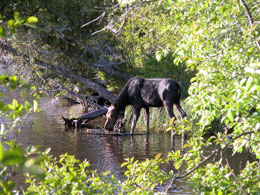Does a Moose Hibernate or Migrate Where Does a Moose Put Its Baby When Its Born

Cows give birth to calves in late May when it is however cold and spring has non yet really arrived in the boreal forest. At this time moo-cow moose are malnourished and not nonetheless recovered from the past winter'south ticks. It seems too early, but an early outset is essential then that calves are prepared to survive winter.
At nascence calves weigh only 30 pounds, simply tin can walk within hours of birth. For the first 2 months of life, much of the calf's nourishment comes from the female parent's milk. Calves begin testing different foods inside a couple of weeks, and by late July calves swallow large amounts of vegetation. Past late fall, calves are fully weaned. At this time, healthy calves weigh 300 pounds, about x times their birth weight.
For an unabridged yr, calves depend on the protection of their mothers. A healthy female parent is a formidable defence.
Typically, viii of every ten cows are pregnant each fall. By the post-obit spring, ten months afterwards, only one or ii of every ten cows yet accept a surviving calf. By some standards the survival of a calf is miraculous; past any standard information technology is confronting the odds.
Only before their commencement birthday, when cows are set to give birth again, calves are rejected by their mothers. Subsequently existence with their mother for every moment of their lives, they begin a largely solitary existence.

While many cows are in the last months of pregnancy and raising a young calf, bull moose begin re-growing antlers each jump. During pinnacle growth, antlers may grow three-quarters of an inch in a single day. During summer bulls spend almost 25% of their energy growing antlers. This is energy that otherwise would have increased body reserves necessary for surviving winter.
By Autumn, antlers cease growing and bulls prepare to mate. So focused are bulls at this time that they stop eating for a couple of weeks, and may lose 100 or more than pounds. They use their antlers to compete with other males and attract females. Mating success is non guaranteed. Only healthy, experienced bulls mate. Success is determined by antler size and symmetry.
In early wintertime, bulls shed their antlers. They confront winter handicapped by the legacy of their antlers. If they survive, they volition begin growing new antlers in spring. Each yr bulls grow larger antlers. They dice soon after erstwhile age makes information technology incommunicable for larger antlers.
Antlers are extravagant and disposable sex symbols, like a young human in a hot sports machine. Why spend and so much on antlers? It seems and so wasteful.

Surviving the winter means nil if doing and then comes at the toll of non mating. Antlers are a sign of male fitness and health, and are usefully thought of as a handicap. Only the fittest moose are able to devote substantial energy to antler growth. A moose in poor health is unable to grow large antlers, and in this mode antlers are an honest sign of a moose's fitness.
Whereas cows may only requite birth every other year, bulls nurture their antlers every year. This intensity takes its toll. Compared to moo-cow moose, bulls accept higher rates of osteoporosis and arthritis and shorter life spans.
During summer, moose consume xxx to twoscore pounds of vegetation a twenty-four hour period. That would exist like you or me eating 7 pounds of salad every day. Because each bite may contain merely a few grams of nutrient, moose bite and chew several thousand times every 24-hour interval. Moose patiently feed for nigh 8 hours every solar day.
Moose forage is voluminous, but not very rich in diet. To accommodate this kind of food moose possess ane of the well-nigh complicated digestive systems e'er created past Mother Nature (aka, natural option). To go the virtually out of their food, moose digest information technology a bit, regurgitate it, chew on the cud, and re-swallow it for a second round of digestion. Moose patiently chew their cud about eight hours every day.
In preparation for winter, moose increase their body weight past as much as xx-five pct. Imagine gaining xx-five pct of your trunk weight by eating just vegetable salads – no salad dressing, just the salad.

More whatsoever other member of the deer family, moose spend fourth dimension in the water. The moose's association with water is so distinctive that moose may appropriately be considered the hippopotamus of the north country.
Moose are well-suited for spending time in water. Long, strong legs let moose to walk hands in shallow waters and swim in deeper waters. Moose also have large, complex noses. Of all members of the deer family, moose have the biggest noses. The narial architecture of a moose includes massive cartilage, specialized muscles, folded and recessed peel, and fatty pads (see lower image). All these features may represent a complex, nostril-endmost system, that allow moose to forage underwater without breathing in any water.
Aquatic environments offer much to moose. Water brings coolness. In the water, moose reduce their respiration rate by almost xxx%, and their overall energy expenditure by virtually 10%. Water also brings nutrition. Of all the food that moose consume, aquatic plants are the richest in poly peptide and sodium. Water also brings safety. Even a weak, vulnerable moose is considerably safer from an attacking wolf when continuing in just a few feet of water.
For moose, winter is full of suffering and triumph over that suffering. It is not the common cold. Moose are inappreciably bothered by cold. It is the difficulty of getting food. During winter, moose mostly eat twigs from deciduous trees and shrubs and the twigs and needles of balsam fir and cedar. Each seize with teeth of nutrient is a mere gram – just i/28th of an ounce. Moreover, twigs and needles contain but one third the diet of leaves that moose eat during summer.
The fare is not only meager, but also difficult to assemble. The snow is deep and moving from tree to tree is difficult and energy consuming. Imagine yourself walking through chest or human knee deep snow from tree to tree collecting virtually 9 thousand twigs – one twig at a fourth dimension – every 24-hour interval. This is how moose – an 800 or 1000 pound animate being – survive the wintertime.
When snowfall is deep and foods sparse, moose restrict their intake of food because the costs of eating exceed the gains. Moose pass much of the winter resting and ruminating, in solitude and hunger. Ultimately, moose lose weight every single day, for about 5 months of every twelvemonth. Nonetheless, most moose live to see the jump that follows each wintertime.
One might rightfully retrieve that moose are awe-inspiring for their adaptations to winter. Just as rightfully, 1 might also recall that wintertime is full of suffering and triumph over suffering. It is quite a powerful affair to give one's attention to another'southward suffering and triumph.
Source: https://isleroyalewolf.org/overview/overview/moose.html
0 Response to "Does a Moose Hibernate or Migrate Where Does a Moose Put Its Baby When Its Born"
Post a Comment